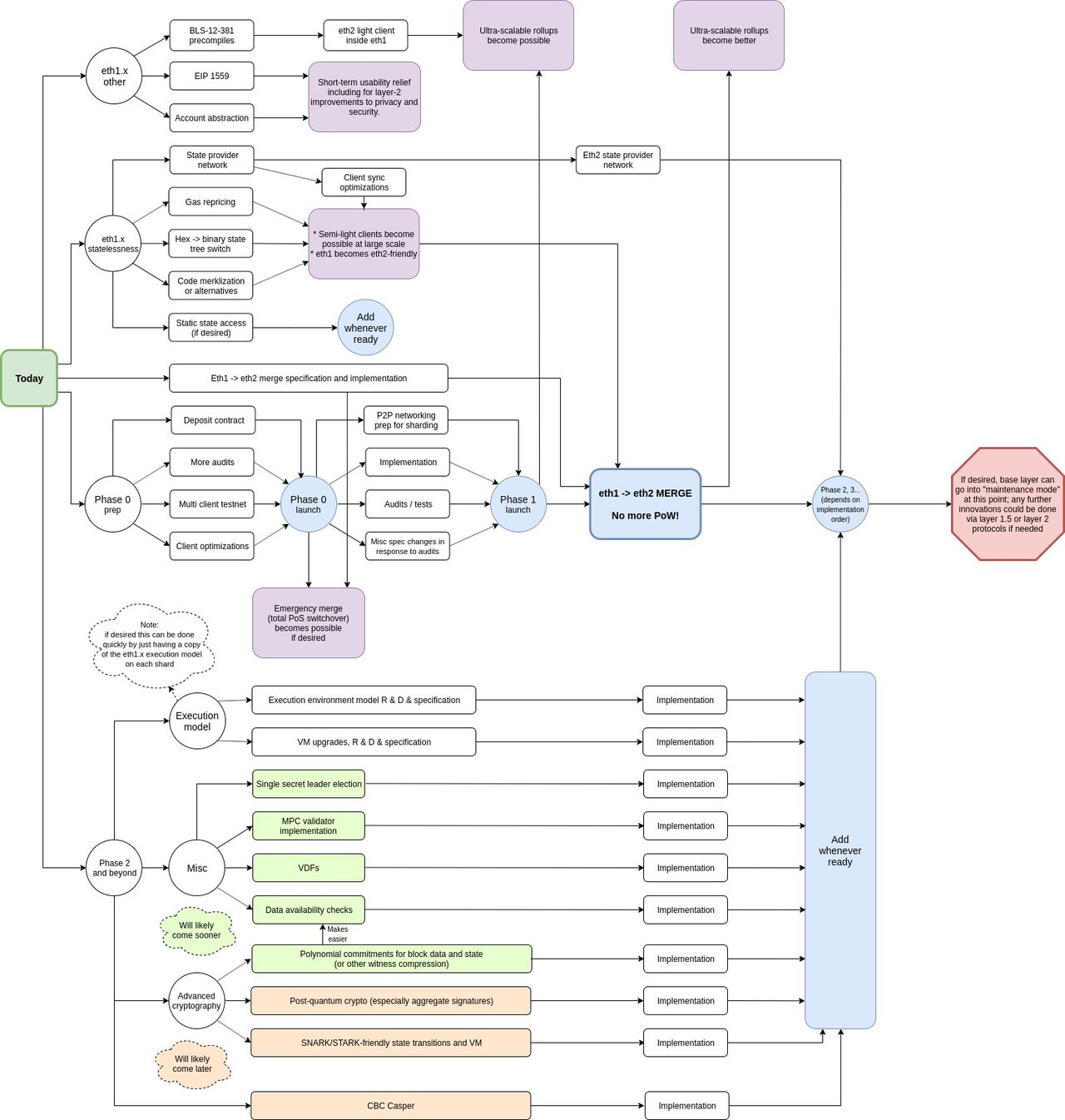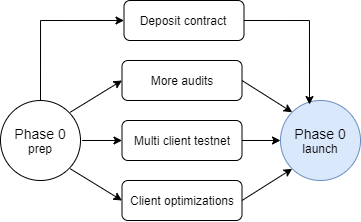Perspectives | Ethereum 2020: Roadmap and Outlook
What surprises will Ethereum bring in 2020?
You may have missed a message when Vitalik Buterin tweeted "Ethereum Roadmap in My Mind" on Twitter. So are you also curious about the meaning of the pictures he published, what are the highlights of Ethereum this year?
I used hyperlinks to add hyperlinks to the pictures he published, and we can also preview the highlights of Ethereum in 2020.
Two swords together: Extending Ethereum's throughput with proof of stake and sharding
Here is a Vitalik personal Ethereum roadmap marked with a hyperlink. The choice of links is of course my own responsibility, and the graphics are still attributed to Vitalik.
- Opinion | Wang Qian of Jilin University: The Central Bank will definitely face fierce competition between private and fiat currencies in the future
- Prediction | Data show that the probability of BTC breaking 10,000 by June is only 16%
- Embarrassing or strange new narratives: Bitcoin is to money, like 0 to mathematics

-Translator's Note: The picture here does not show the hyperlink added by the author, it is still the original picture published by Vitalik. For hyperlinks added by the author, please read the original text-
There are four large blocks in this picture, from top to bottom:
- "Ethereum 1.x Miscellaneous"
- "Ethereum 1.x stateless"
- A "core" that merges from Eth2 Phase 0 to eth1-> 2 and surrounds the removal of proof-of-work (PoW)
- eth2 Phase 2 and later
The horizontal horizontal axis in the middle indicates the sequence of time. On this axis is the core part, starting from Phase 0, starting Phase 1, and then "big merge": eth1-> eth2 merge . The big merger relies on three premises:
- Eth2 Phase 1 starts
- eth1-> eth2 technical idea and implementation of merger
- Eth 1.x stateless
After the merger is successful, the system can abandon the workload proof, and the user no longer needs to run an Eth1 client and an Eth2 client to track the two blockchains. Ethereum will become a fragmented proof-of-stake system. Beacon chain and fragment chain . The state of Eth1 will be stored on slice 0. Users can continue to use their usual applications and send transactions as usual.
The big merger is a huge leap in the scalability of Ethereum, which requires huge engineering work to support its possibilities and enable it to operate safely and securely. The above premise points out the classification of work.
There is much to discuss about major mergers and other issues. Here we only discuss the core progress and "Ethereum 1.x Miscellaneous", because they are more related to Ethereum's 2020. Let's start with Ethereum 2.0 Phase 0.
Ethereum 2.0 Phase 0
The part most likely to go live in 2020 is the beacon chain .

The main prerequisites for the beacon chain to start are:
- Deploy Eth2 margin contract on the Eth1 main chain;
- At least two, and ideally three Eth2 client teams, should have software versions available for production
- After the release of the margin contract, at least 16,384 validators deposited the margin (the accumulated amount of which is at least 524,288 ETH)
Why is the beacon chain likely to be launched in 2020?
Danny Ryan, Diederik Loerakker, and four teams have all been building Eth2 clients for production. (In alphabetical order) The clients being built are: Lighthouse , Nimbus , Prysm , Teku , Trinity .
The Ethereum Foundation, as well as other teams (such as Artemis, Harmony, Lodestar, Nethermind, and Parity), as well as those who develop pledge services, and even newcomers who have just arrived, have also contributed to this to varying degrees. There are also some audits in progress.
The mission to launch the beacon chain in 2020 is clear and focused. Most of the work has been done in a distributed manner.
From an economic point of view, attracting 16,384 validators (524,288 ETH) with an annualized return (APR) of more than 20% is attractive regardless of the method used (at the same time, the annualized return will It decreases as the number of validators increases).
-Source: Validator Yield Calculator included in the hyperlink above-
How to contribute to beacon chain 2020?
The production version of the beacon chain client is expected to be released after the multi-audit and multi-client test network can run stably for a period of time; multiple single-client test networks have been running stably for a period of time, although optimization and optimization under high load are still needed. Commissioning work.
Ethereum always welcomes more contributors. The areas that need to be contributed include: client-to-peer network setup, client interoperability, commonly used testing tools, client and network security, performance, and stability.
Experts in the fields of hacking, security, EVM, and smart contracts, auditing margin contracts and evaluating Runtime Verification will always require your help. Although the bytecode of the margin contract has not yet been deployed on the main chain, you You can go one step ahead, because there is no expectation that the margin contract will change.
Ethereum 1.x needs help
The top part of this illustration, "Ethereum 1.x Miscellaneous", is related to the current Ethereum mainnet.

This part can be divided into three projects. Roughly speaking, there are three EIPs. Dedicated contributors are required to be deployed on the main network in 2020.
BLS12-381 has been precompiled by Alex Vlasov of Matter Labs for several months, and EIP2537 is in the works. EIP 2537 adds support for the BLS12-381 curve used by Eth2 , making smart contracts a light client for Eth2. With the pre-compilation of the BLS12-381 curve, the new smart contract can verify the data from the Eth2 shard. Eth2 Phase 1 will introduce shards when it starts, which can improve the data availability of the Rollup scheme on Eth1. The Rpllup solution is actually a kind of smart contract. Most of its calculations and storage are placed off-chain , but some data will be sent to the chain for emergency needs. Without average data availability, Rollup's throughput can become even greater. With the work of Alex Vlasov, the precompilation of BLS12-381 is likely to be introduced in 2020 (maybe even earlier than the beacon chain).
EIP-1559 may bring some benefits to users, because users will be able to ignore the setting of Gas fees when sending transactions, and the Warriors can guarantee that they will not pay excessive fees and will not wait for unreasonable delays. The EIP wrote: "It is expected that most users will no longer need to manually set Gas fees, even if the transaction activity in the network is very frequent." In addition, the EIP also includes the setting of burning fees, which will help hedge ETH deflation , But without the need to drastically cut miners' earnings. Since the EIP was proposed a year ago, some people have done some work for it, but no one has stepped forward to do so now.
Account abstraction is to allow users to create accounts with arbitrary authorization logic (Translator's Note: Make account creation free from the constraints of the Ethereum protocol itself). The additional flexibility may have far-reaching effects. Let us take an example here: a multi-signature smart contract wallet can use its own funds to pay its transaction gas fees. As long as there is a wallet with funds in it, there is no need for another account holding ETH to interact with this wallet and pay for Gas. The reference to account abstraction dates back to 2015, but a proposal a month ago made it possible to achieve account abstraction in 2020.
If you want to learn more or contribute, please join https://gitter.im/ethereum/AllCoreDevs (this is a chat room between core developers).
"Ethereum 1.x statelessness" also needs support, but this is a big topic. You can check out this roadmap proposed for "stateless Ethereum" and the " Ethereum Foundation Blog" 1.x Files "series.
Tribute to the Geth team
Last week, the Geth team released the 164th version on Github. We should not forget that the Geth team has been adding features, improvements and optimizations to the Ethereum Geth Client . It's easy for people to take their work for granted and forget their hard work. Let's pay tribute together (ranked alphabetically, no matter what the order) Guillaume Ballet, Zsolt Felföldi, Felix Lange, Gary Rong, Adam Schmideg, Martin Holst Swende and Péter Szilágyi!
Felix, Martin, and Péter have done many years of Geth optimization and upgrade work, which can be traced back to the "Shanghai Attack" period (the teammates at that time include Nick Johnson and Jeffrey Wilcke) (Translator's Note: "Shanghai Attack" refers to 2016 (DoS attack that broke out on the Ethereum network during Devcon2 in Shanghai).
A few months ago, Péter was a guest at a developer round table hosted by ConsenSys . He shared some thoughts on Eth2, statelessness, and contributor incentives, as well as those he admired (in the 49th minute of the video attached to the hyperlink). Thank you for your reminder, Péter, and for the important work you and your team have done.
To thank them, learn from them, or contribute to Geth, join the Discord channel on Go Ethereum .
Ethereum 2020 and others
From the current perspective, the rough sequence of possible developments on Ethereum is as follows:
- Beacon Chain (Eth2 Phase 0) launched in 2020
- LS12-381 curve precompilation will be launched in 2020 (maybe this is the earliest)
- If someone comes to drive account abstraction and EIP 1559, they are likely to launch in 2020
- Eth2 Phase 1
- Eth 1.x stateless
- eth1-> eth2 big merger
- (Follow-up) execution mode, privacy and security enhancements, advanced cryptographic components
The beacon chain is the project that most people are committed to achieving in 2020. " Eth2 looks pretty good-Phase 0's specifications have been finalized, and the client team is going through the storm ." On Eth1, the Geth team will move on, and BLS12-381 curve precompilation may be introduced in 2020 (maybe launched earlier than the beacon chain). However, EIP 1559 and account abstraction need to be the key players before they have the opportunity to launch in 2020. This roadmap also talks about many things that are moving forward in parallel, maybe we can discuss in subsequent articles: please follow me to see my developments . Under COVID-19, please take care of yourself.
I think I will also add the acknowledgment section in later articles. So my next thanks to the Solidity team. They will deliver an opening speech at the 2020 Solidity Summit .
(Finish)
Original link: https://ethos.dev/ethereum-2020-roadmap/ Author: ethos.dev Translation: A Sword
We will continue to update Blocking; if you have any questions or suggestions, please contact us!
Was this article helpful?
93 out of 132 found this helpful
Related articles
- Industry Blockchain Weekly News 丨 Listed companies enter annual report season, blockchain becomes a key word
- Babbitt Column | Interpretation of the French Central Bank's Digital Currency Experiment: Open Cooperation Institution Recruitment officially launched in the third quarter
- Babbitt weekly selection 丨 US $ 6 trillion stimulus policy favors Bitcoin; how important is blockchain in China's tens of trillions of "new infrastructure"?
- With the advent of negative interest rates, can the stablecoin maintain a 1: 1 anchor with the US dollar?
- Journal of Party and Government Studies | Government Governance Practices of Blockchain Technology: Applications, Challenges, and Countermeasures
- MOV is officially launched, creating an ace DeFi infrastructure, making transactions everywhere
- How much does God V have? We have estimated their net assets







